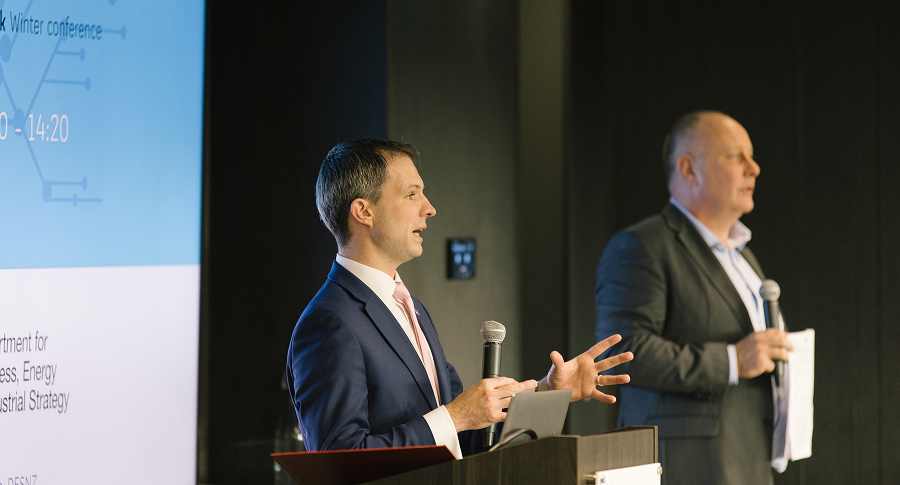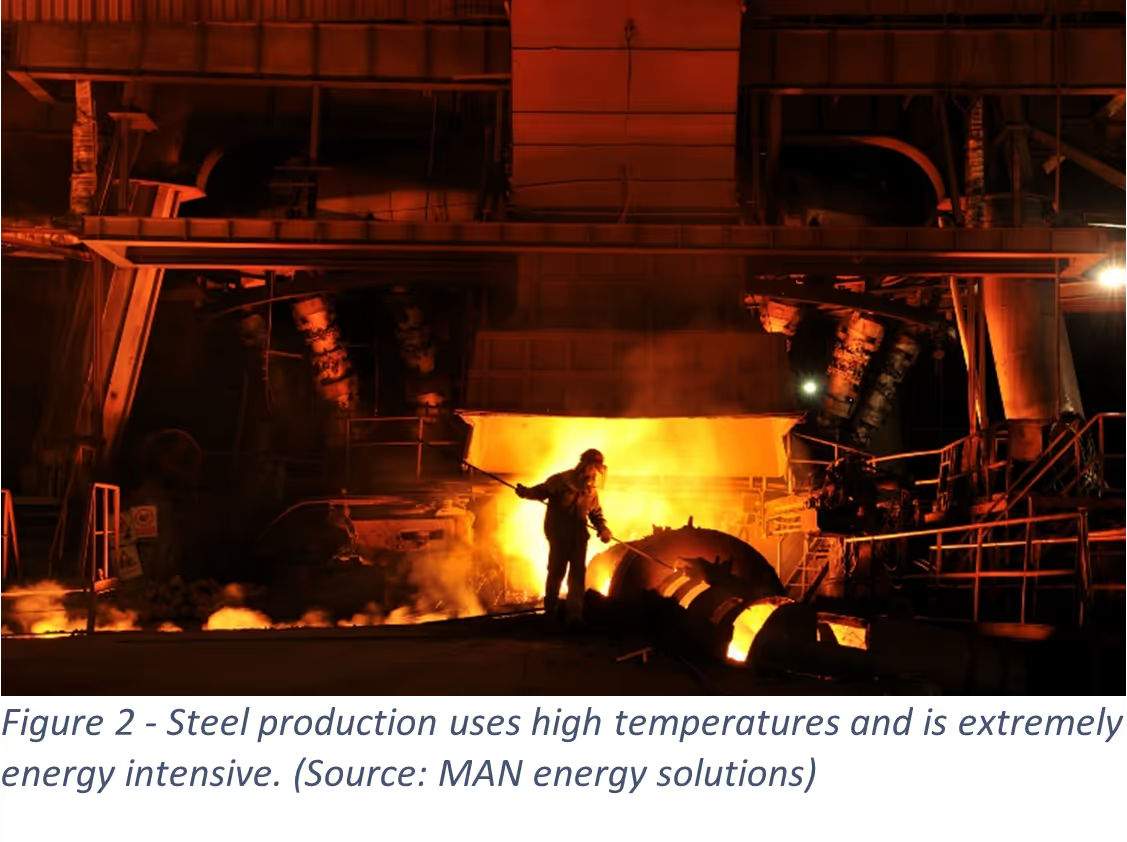In this blog, Grace Millman considers the potential application of hydrogen to decarbonise the industrial sector, exploring the steel and cement industries in particular.

In this blog, Grace Millman considers the potential application of hydrogen to decarbonise the industrial sector, exploring the steel and cement industries in particular.

As a new low carbon fuel source, hydrogen could be used across a broad range of applications to meet existing and future sources of energy demand. One such target area for hydrogen-based solutions is the industrial sector (including heavy industries in steel, cement, and chemicals) which is currently responsible for 15% of global carbon emissions and 16% of UK emissions.1,2
Industrial sectors of particular interest for hydrogen-enabled decarbonisation include:
Currently, the UK produces c. 27 TWh of hydrogen; almost all of which is grey hydrogen that is produced from the reformation of natural gas with significant carbon dioxide emissions as a by-product.3 Grey hydrogen is mainly used as a desulphurisation chemical in refining, for the production of ammonia and in some industrial processes. Replacing the existing use of grey hydrogen with low carbon hydrogen would be an obvious place to start and would have an immediate carbon reduction benefit. Low carbon hydrogen can also be used as a chemical feedstock, a combustible fuel, a reactant to remove impurities, and in the decarbonisation of industrial materials, such as steel, cement, and aluminium.
A big challenge for a new energy source is to match hydrogen demand and supply. Expanding the use of hydrogen in industrial clusters could be one route to grow the UK's hydrogen market, encouraging industrial users to aggregate demand, enabling hydrogen production to scale up, and providing a catalyst for innovation and new end-use applications to develop.4 From these initial clusters, hydrogen supply chains could then expand into other sectors and across a wider geography.

It has been estimated that, with the right industrial strategy, the combination of public policy push and market-oriented pull activities would enable wider-scale deployment that could reduce global greenhouse gas emissions from industry by over 30%.5
The main UK industrial clusters identified for hydrogen have been centred around existing refining and petrochemical industries including Teesside, areas in the north west around Runcorn and Stanlow, Grangemouth, Foley, and in south Wales around Milford Haven, as seen in Figure 1. The proximity of these clusters to oil and gas infrastructure could lend itself to the production of blue hydrogen, manufactured via the reformation of natural gas methane and using former oil and gas wells to store the captured carbon. Blue hydrogen, however, faces a number of challenges including the need to significantly improve the efficiency of the carbon capture process, which is at present approximately 65% efficient, and the cost of carbon storage. Blue hydrogen also maintains a dependency on natural gas which, with the depletion of gas fields in the Irish and North Sea, will increasingly rely on imports.
Alongside blue hydrogen, policy makers are considering the development of green hydrogen, produced via electrolysis and requiring low-cost electricity, as being the ultimate future aim as it produces zero carbon emissions. Green hydrogen could also be better integrated into a future net zero energy system, powered by very large-scale renewable electricity. It is significant that many oil and gas companies are actively developing offshore wind projects, that could be combined with the production of green hydrogen for industrial sectors.6,7
Two examples of hydrogen as a decarbonisation option in industrial processes are explored below.

An example of hydrogen's flexibility is its potential application in the production of steel. Using hydrogen in the production of steel has high decarbonisation potential, because hydrogen can be used as the source of heat and the reducing agent, which is normally achieved using coal. This is referred to as direct reduced iron (DRI) and does not require a furnace to melt the ore. Today, around 7% of steel is made using DRI, which makes steelmaking the fourth biggest global user of hydrogen.8 The existing demand within the steel industry could act as 'low-hanging fruit' to decarbonisation via low-carbon hydrogen. Using blue hydrogen in the steel process could reduce emissions by approximately 50%, with even greater reduction potential if green hydrogen is used.9 Thus, the impact could be both immediate and significant.
Scaling up hydrogen use in steel production would result in a 15-fold increase in hydrogen demand from the sector according to the IEA, which would require significant investment and policy support. At current price levels, replacing coal with hydrogen would drive up the price of steel by about one third.10 However, this gap will narrow in the coming years as carbon-emission pricing could penalise fossil fuel users, while access to low cost renewable electricity, efficiency gains from larger-scale hydrogen production, and optimisation of the hydrogen steel-making process will drive down the cost of this alternative. According to a report by consultancy firm McKinsey, 'pure hydrogen-based steel production' in Europe will not become cost-competitive with traditional production until between 2030 and 2040.11
In the UK, cement is the source for 1.5% of CO2 emissions, and is very energy intensive due to the high temperatures required to produce it.12 In 2019, a feasibility study was undertaken by UK government into using a mix of hydrogen and biomass to manufacture cement. More recently, cement producer Hanson UK have been working with Swansea University to develop a new hydrogen demonstration unit in Port Talbot, South Wales. This would produce green hydrogen from renewable energy on site to replace some of the natural gas used in cement production.
Industry faces a real challenge in decarbonising, however there are a number of different fuels that could enable them to reduce their carbon emissions. Hydrogen, electricity, and biomass are all being considered as potential decarbonisation fuels. Each industrial application will have a preferred option which will be dependent on:
Some industries may want to decarbonise incrementally, slowly changing their processes to be zero carbon, while others would prefer to develop innovative processes that do not rely on fossil fuels. British industry is notoriously slow to invest in infrastructure. However, to meet demand and decarbonise, processes will need to be re-engineered rather than just modified, and the industrial sector will need the right support to enable this.
Biomass can generate zero-carbon heat, but biomass supplies are limited and are not best suited to use in direct heating. The potential for electrification of industrial processes could be significant, but it would entail an overhaul of existing equipment, which could be expensive. In many cases, the suitability of hydrogen, or equally the unsuitability of electricity, can be determined by the temperatures needed:
A 2020 study found that 78% of European's industry energy demand is already electrifiable using established technologiesii. However, some electrification technologies have still only been demonstrated at a pilot scale. If these can be developed, a large proportion of industry could be electrified, reducing the amount currently considered hard to decarbonise. According to Stephen Carr, lecturer at the University of South Wales, this leaves c. 15 TWh of industrial fossil fuel energy where hydrogen is the only suitable alternative.16 This agrees with findings from the CCC, which found that out of 90 TWh of current fossil fuel consumption that could be switched to hydrogen by 2040, 15 TWh can only be decarbonized via hydrogen. According to the CCC, hydrogen could also be helpful in the decarbonisation of "more distributed sources of CO2 emissions (e.g., from the food and drinks sector)", which they say would be impractical and costly to capture through CCUS.
Industrial processes need to embrace innovation and reinvent themselves to achieve decarbonisation, rather than try and adapt existing processes, which will allow them to take advantage of low carbon fuels. Hydrogen has a very important role in achieving full decarbonisation of the industrial sector, however using it as a widespread solution will result in delayed emission reductions and potentially increased costs. As with most applications of hydrogen, it should be used where it adds the most value and has the greatest decarbonisation potential. This includes in the steel and cement industries, and as a chemical feedstock.
Sign up to receive our monthly newsletter containing industry insights, our latest research and upcoming events.